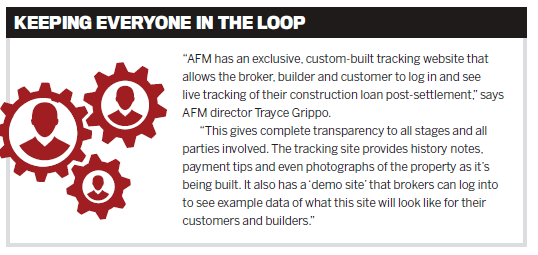Non-bank lender Australian First Mortgage on how brokers can bring customers' blueprints to life

Non-bank lender Australian First Mortgage on how brokers can bring customers' blueprints to life
Helping a client build a home from the ground up might seem like a daunting process, but just imagine how much more overwhelming it would be for a first-time client if they didn’t have guidance, advice or support from an experienced broker.
Becoming an educated construction finance broker will not only open new doors for your business, but will also allow you to offer a crucial service to time-poor clients who can’t navigate this process alone.
According to the ABS, residential construction work completed in the 2017 December quarter was valued at $17.8m seasonally adjusted. Here’s what you need to know to tap into this vast market and bring your clients’ blueprints to life.
Upfront conversation
Construction loans are suitable for anyone wanting to purchase land and build a new home. This has become a popular option for first home buyers and investors who want to accrue equity in a new property over time.
When a client is considering this route, Australian First Mortgage director Trayce Grippo says it’s important to make sure the borrower is aware that they’ll need to pay for their construction loan while not receiving rent (if it’s an investment property) or while paying rent (if it’s owner-occupied). Clients should make sure they have a buffer in case the construction timelines get extended.
“Ensuring your customers have a full understanding of their construction property loan, value and location is vital for a successful purchase and loan transaction,” Grippo says.
Next, brokers need to choose a lender that has an appetite for construction lending; this will simplify the process and ensure the customer has a positive experience, she says.
Acceptance Finance credit adviser Matt Mannaert agrees. An experienced construction finance broker based in Melbourne, Mannaert says it’s important for the lender to have a dedicated construction team, great BDMs who return calls quickly and a good product that’s not too heavy on fees.
Collaborative construction
One of the most important traits of a good broker is being hands-on and highly communicative with clients. That’s especially important when it comes to construction finance. Clients will often need more assistance upfront to understand the additional requirements involved when building a brand-new property, Grippo says.
They’ll also need to have a good understanding of the different stages of a construction loan once the purchase of their land settles. A construction loan has two components: a land settlement and a construction phase. Depending on the lender’s processes and policies, there are generally two to five progress valuations done during construction to ensure the building is being completed as per the building contract. Invoices need to be signed by the customer at each stage, and the lender pays the builder in five stages.
The transaction involves multiple parties, including the builder, developer, valuer (who conducts progress inspections) and the lender (who will have to pay the builder in stages), not to mention the solicitors and referrer. All in all, construction finance demands an agile broker who can juggle multiple people at once and keep them all informed on the project’s progress.
“All of our construction loans are for residential purposes, therefore residential mortgage brokers are perfect to write these loans” - Trayce Grippo, AFM
Mannaert describes it as “working hand in hand” with multiple parties on one transaction. “Together with my team, we aim to be across all aspects of the transaction and the deadlines involved so that finance approval and settlement milestones are met in a timely fashion,” he says.
To make the process transparent at all stages and for all parties involved, AFM has created a tracking website that allows the broker, builder and customer to log in and track the progress of the construction loan post-settlement.
“Our tracking site gives history notes, payment tips and even photographs of the property as it’s being built,” Grippo says.
What’s in it for brokers?
Because AFM’s construction loans are for residential purposes, residential mortgage brokers are perfect to write these loans, Grippo says – although she adds that customers’ needs will be slightly different, as they’ll likely need extra support and education in the post-settlement construction process.
Brokers who want to diversify into construction fi nance and become experts in this fi eld will be able to expand their opportunities for new referrals. For instance, when brokers use tools such as AFM’s exclusive construction tracking portal, they gain a unique selling proposition that will help them add builders and property groups to their referral network, Grippo says.
Mannaert says he enjoys this type of work because he shares common goals and mentalities with his investor clients.
“Although the work involved in each transaction is about double a normal purchase deal, due to the amount of liaising with all parties, progress draws, etc.,” he says, “I find it very rewarding seeing clients grow their portfolios and the capital growth achieved.”




